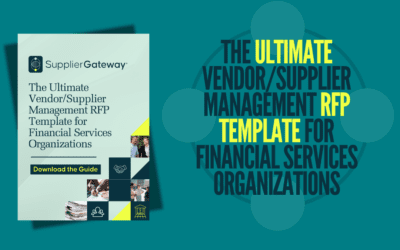Ever wondered why supplier data management for healthcare is important?
You know the old saying “Garbage in, garbage out.” This applies to your healthcare supply chain management as much as anywhere else. If you don’t have accurate, high-quality data about your suppliers and the products they provide, you’re going to end up with inefficient processes, higher costs, and frustrated clinicians and staff.
The key to streamlining your supply chain, reducing excess inventory, and ensuring you have the right products available when and where they’re needed is simple: invest in collecting and maintaining the best supplier data possible. We’re talking about details like accurate contact info, real-time updates on backorders or discontinuations, lead times, pricing, and compliance documentation.
With top-notch data powering your supply chain management systems and processes, you’ll gain visibility and control. You’ll be able to identify cost-saving opportunities, spot potential issues before they arise, and make better decisions about which products and suppliers to rely on. Best of all, you’ll improve patient care by enabling clinicians and staff to do their jobs without hassle or delay. Read on to discover the key strategies and best practices for achieving high-quality supplier data in your healthcare organization. The rewards will be well worth the effort.
Why Supplier Data Matters in Healthcare
Accurate and up-to-date supplier data is key to improving supply chain management in healthcare. Without it, hospitals and medical centers are operating blind. You need to know the nitty-gritty details about your suppliers to make the best choices for your organization.
Supplier data gives you visibility into your supply chain so you know what’s coming and going in real time. This means you can spot potential issues early and make adjustments to avoid disruptions in patient care. You’ll have information on supplier performance, quality, and sustainability readily available to determine the optimal partners for your needs.
Supplier data also facilitates open communication and data sharing with your suppliers, building stronger relationships and allowing you to work together more efficiently. When you have a complete, high-quality profile for each supplier, you can evaluate them objectively based on factors like:
- Product quality and safety – Ensuring medical supplies and equipment meet strict standards.
- Punctuality and reliability – Delivering critical items on time is a must.
- Pricing and value – Getting the best deal for high-demand, high-cost supplies.
- Innovation – Finding suppliers pushing the envelope with new solutions and tech.
- Sustainability and social responsibility – Choosing eco-friendly and ethical suppliers when possible.
At the end of the day, high-quality supplier data translates into higher-quality patient care. While compiling and managing this data requires significant effort and resources, the benefits to your healthcare organization and the communities you serve make it well worth the investment.
Challenges With Supplier Data Management
As a supply chain manager in healthcare, you know the challenges of managing high-quality supplier data all too well. There are a few major issues that often get in the way:
- Lack of internal organization or a centralized data management system. When supplier data lives in silos across your organization, it’s nearly impossible to get a full, accurate picture or leverage it effectively. You need a system that brings all supplier information together in one place.
- Lack of expense visibility and inefficient audit controls. Without comprehensive, up-to-date supplier data, you can’t properly analyze expenses or ensure you’re paying the right prices. Audits also become tedious and time-consuming. Consolidating information makes these processes far more efficient.
- Difficulty integrating new supplier data. Onboarding new suppliers is hard enough without having to chase down information from various departments and enter it into multiple systems. Robust supplier data management software centralizes information from the start, making the integration of new partners a breeze.
The challenges of managing high-quality supplier data in healthcare are significant, but the benefits of overcoming them are huge. By investing in the right tools and processes to organize, centralize and keep supplier information up to date, you’ll gain visibility, tighten control, streamline workflows, and ultimately cut costs. The key is high-quality, comprehensive data – and with the right solution, you can have it.
Key Attributes of High-Quality Supplier Data
To effectively manage your healthcare suppliers, high-quality data is essential. What exactly constitutes “high-quality” supplier data? There are several key attributes to consider:
Accuracy
Accurate supplier data means the information is correct and factual. Things like supplier names, addresses, and contact details should be double-checked to ensure they are right. Inaccurate data leads to errors, compliance issues, and impaired supplier management.
Completeness
Complete supplier data means no missing information. All relevant details about each supplier should be included, such as tax IDs, licenses, certifications, and more. Lacking important supplier information prevents full visibility into your supply chain.
Reliability
Reliable supplier data comes from credible sources and is backed by evidence. The information should be verifiable and trustworthy. Unreliable data from questionable sources leads to poor decision-making and increased risks.
Timeliness
Up-to-date supplier data means the information is current. Outdated supplier data results in lost opportunities, compliance failures, and wasted time. Best practices are to review and refresh supplier data regularly, at least annually.
Consistency
Consistent supplier data means the information is formatted and categorized uniformly. When data is inconsistent, it becomes difficult to analyze, report on, and manage suppliers effectively. Standardizing how supplier data is entered and maintained is key.
High-quality supplier data is accurate, complete, reliable, timely, and consistent. By prioritizing and achieving these attributes, you’ll be on your way to improved healthcare supply chain management and oversight. The time and effort invested in building a high-quality supplier database will pay off through greater efficiency, risk reduction, and cost savings.
Best Practices for Collecting and Maintaining Supplier Data
To collect high-quality supplier data for your healthcare organization, follow these best practices:
Align internal stakeholders
Get leadership, procurement, IT, and other relevant teams on the same page about why improved supplier data is important and what specific objectives you want to achieve. Set key performance indicators (KPIs) to measure the success of your data collection efforts.
Centralize supplier information
Use a supplier master data management system to store all supplier information in one place. This helps avoid duplicate, outdated, or contradictory data living in different departments. Give relevant teams access to the centralized database to update and maintain supplier records.
Streamline data collection
Create a standard questionnaire for new and existing suppliers to fill out with consistent fields of information. Make the process as simple as possible by allowing suppliers to enter data into an online form. You may need to follow up with phone calls to suppliers for clarification or to capture additional details.
Apply data quality checks
Validate and verify supplier information to ensure it is correct, complete, and consistent. Double-check facts provided by suppliers and look for any missing or illogical data. It may help to do site visits to suppliers when possible. Use data quality software tools that can detect anomalies in records.
Keep information up to date
Review and refresh supplier data on an ongoing basis. Stay in regular contact with key suppliers to gather the latest information about their company, products, services, and compliance or performance metrics. Make updating supplier records an integral part of the procurement process.
Following these best practices for high-quality supplier data collection and management will enable your healthcare organization to build a comprehensive and accurate supplier master database. This foundation will support an optimized supply chain that reduces costs, improves patient care, and ensures regulatory compliance.
Leveraging Supplier Data to Drive Cost Savings and Efficiencies
Analyze Your Supplier Data
You’ve collected information from your suppliers, now it’s time to unlock the insights hidden within. Analyzing your supplier data can uncover:
- Cost savings opportunities. Look for suppliers charging higher prices for similar goods or services. You may be able to negotiate lower rates or switch to alternative suppliers.
- Areas of risk. Suppliers with quality, delivery, or financial issues can put your supply chain at risk. Identifying these suppliers allows you to take corrective action.
- Trends in spending. Understanding how much you spend with each supplier and on each category of goods and services helps optimize your budget and identify waste.
Standardize and Centralize
To get the most from your supplier data, it needs to be:
- Standardized. Require all suppliers to provide information in the same format to allow for easy analysis and comparison. Things like using a standard set of product categories and a consistent unit of measure for pricing.
- Centralized. Keep all supplier data in one place, like a procurement management software system. This makes the data accessible across your organization and simplifies reporting and analysis.
Leverage Technology
Modern technologies can help transform your supplier data into a strategic asset:
- Analytics tools detect patterns and insights in large, complex data sets. They can identify cost-saving opportunities and supply chain risks that would otherwise go unnoticed.
- Artificial intelligence uses machine learning algorithms to analyze supplier data, uncovering hidden insights and providing recommendations on ways to optimize.
- Data visualization software transforms raw data into easy-to-understand charts, graphs, and dashboards. Visualizing your supplier data makes the insights more accessible and impactful.
Leveraging high-quality supplier data and technology provides an opportunity for significant cost savings and supply chain efficiencies. By unlocking data-driven insights, you can make more informed supplier selections, streamline purchasing processes, and optimize budget utilization. The key is collecting comprehensive data, keeping it standardized and centralized, and using the latest analytics tools to transform it into actionable business intelligence.
Conclusion
So there you have it, the not-so-secret key to improving your healthcare supply chain management. Focus on your supplier data. Make it a priority to collect accurate, consistent, and up-to-date information from your suppliers and actually use that data to gain visibility into your supply chain. Only then can you start optimizing processes, reducing excess inventory, and ultimately improving patient care. It may require initial investments of time and resources, but the long-term benefits to your organization and community will make it well worth the effort. Stop wasting time and money on outdated methods and incomplete data. Take control of your supply chain today by making high-quality supplier data the foundation for success. Your patients and bottom line will thank you.
When you’re ready to organize your supplier data and make it work for you, reach out and get more information from one of our experts.












